The BUCG greenhouse “complex," is a joint project that began in April 2017 with BUCG (Beijing Urban Construction Group) and the Prins Group, for the building of new, modern tomatoes and lettuce production greenhouses in Miyun, Beijing. The total production area is 3.3 hectares, including 2.2 hectares of small tomatoes, 2200 square meters for propagation and 2200 square meters for the production of hydroponic lettuce. The project is situated at what will be the entrance of the future agricultural eco-tourism park in Beijing, and will establish itself as not only a production center, but also a center for education and research.
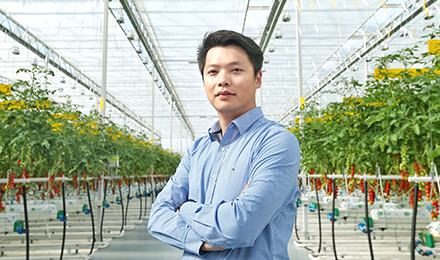
An important platform for education
Xu’s industry knowledge acquired from studying at Wageningen University combined with his work experience at a high-tech Chinese greenhouse operation has given him adept knowledge that growing is equally as important as the advanced devices that can be used within the greenhouse. After graduating from WUR, he worked at Royal Pride Holland for 2 years, learning and practicing tomato growing technology. A lot of leading horticultural suppliers and greenhouse builders participated in this project, including Svensson, Priva, Stozle, Agrolux and Royal Brinkman.
“Most of the technology utilized for the greenhouse project comes from the Netherlands, making this one of the most advanced greenhouses in China,” Xu said proudly. When completed, the operation will also be open to the public, with an 800 square meter demo greenhouse located onsite, allowing the opportunity for suppliers to demonstrate their products and technologies used in the operation. We foresee this being an important platform for educating and communicating the latest technologies and best practices to the expanding Chinese horticulture industry. Furthermore, we hope to attract some of the younger population into the greenhouse to discover the latest technology the future of our industry.”
LUXOUS 1547 D FR
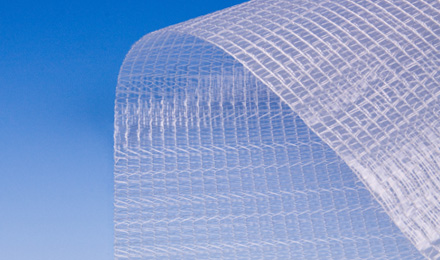
OBSCURA 9950 FR W
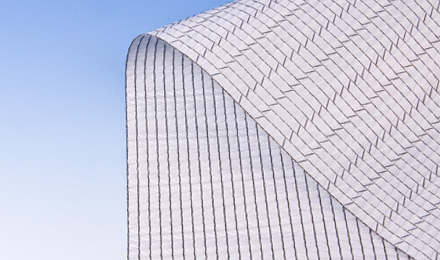
OBSCURA 10070 R FR W
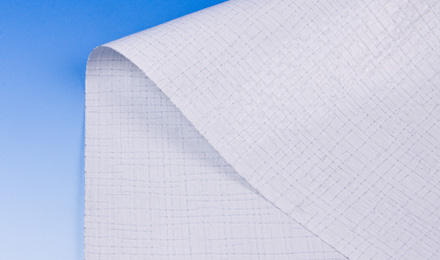
Related articles
Reducing energy cost is the key of vegetable growing in North China
Maximizing energy savings and knowledge transfer
When it came time to select a climate screen supplier, Xu admits that the cooperation with Svensson was no accident. “Svensson is seen as the leading provider in screen solutions and growers from all over the world use Svensson screens to control their greenhouse environments. I know that Svensson has a hundred different types of screens that could satisfy our growing needs. Following the professional climate screen advice we received when working with Svensson, we were able to easily select the ideal screen solution that was well aligned with our goals."
"Considering our cold climate in winter, we opted for a Luxous 1547 D FR screen for energy savings and thanks to its high light transmission, we’re able to use the screen both during the day and at night. Our goal is to utilize as much natural light as possible in the winter, so the transmissivity of the screen was a primary factor. However, due to the smog we encounter, we will also have to use artificial lighting to satisfy the tomato crops light demand. To prevent the escape of the supplemental lighting and keep our neighbors satisfied, we installed a second Obscura 9950 W FR screen for light pollution. Together with our Obscura 10070 R W FR screen for the sidewalls, the white underside of the light pollution Obscura 9950 W FR reflects light back into the greenhouse, which further enhances our supplemental lighting. During winter nights, we’re able to use both our Obscura and Luxous climate screen to further maximize our energy savings."
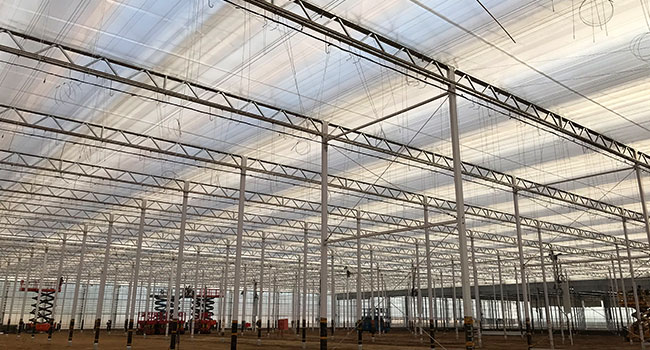
Enhanced climate control
According to Svensson’s calculation, we should be able to save up to 20m3/m2/year with our screening strategy. The heat from the artificial lighting can be used by the greenhouse, which to some extent also helps our energy savings potential. In the propagation and lettuce zones, we selected a Harmony screen based on the screens shade and light diffusion properties. Dan added that they use Svensson Flame Retardant (FR) screens throughout the entire greenhouse for optimum production safety.
Furthermore, after learning about the increased level of light diffusion in the new Harmony range, Xu wants to be one of the first growers in China to look toward such option, as he believes that furthering the light diffusion would better enhance his climate control potential. The construction process is almost complete and Xu hopes that the greenhouse will be put to use by the end of December. Dan concludes that he is looking forward to further communicating with Svensson on how to use his screens for maximum climate control in his greenhouse.